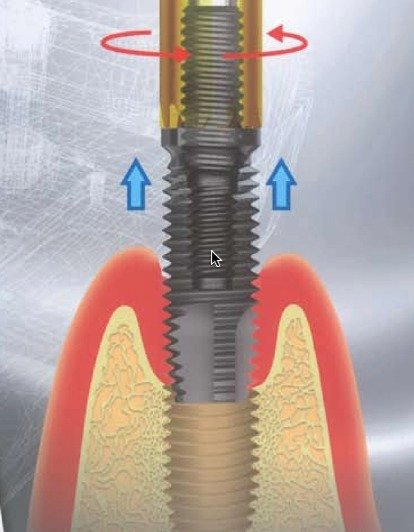
Considering dental implants? While they offer a natural and enduring solution for missing teeth, there may be instances where removal is necessary. In this exploration, we delve into the possibility of removing dental implants, addressing factors such as complications, changes in oral health, or personal preferences. The answer? Yes, dental implants can be removed, but the intricate procedure should only be conducted by a qualified oral surgeon or dentist. The removal involves an incision in the gum tissue, careful detachment from surrounding bone and tissues, thorough cleaning, and stitching. Consultation with a dental professional is crucial to determine the best approach for individual circumstances.

Can You Remove Dental Implants?
Dental implants have become a popular solution for replacing missing teeth. They provide a stable and long-lasting option for those looking to restore their smile and improve their oral health. However, there may be circumstances where a person needs or wants to have their dental implants removed. In this article, we will explore whether it is possible to remove dental implants and the factors to consider.
Reasons for Removing Dental Implants
Implant Failure
- Loosening: If the implant becomes loose, infected, or fails to integrate with the jawbone.
- Preventing Complications: Removal is necessary to prevent further complications.
Discomfort or Pain
- Nerve Pressure: Implant pressing against a nerve or causing irritation in surrounding tissues.
- Improving Comfort: Removal can provide relief and enhance overall patient comfort.
Implant Removal Procedure
Surgical Process
- Professional Expertise: Should be performed by a trained oral surgeon or implant dentist.
- Precision: Involves carefully extracting the implant while avoiding damage to surrounding tissues.
Techniques
- Incision: Depending on factors like implant type and removal reason, a small incision may be needed.
- Unscrewing or Lifting: Some implants can be unscrewed or gently lifted out during removal.
Considerations and Potential Complications
Procedure Challenges
- Complexity: Removal can be more challenging than placement, particularly if the implant is integrated with the bone.
- Bone Grafting: Some cases may require additional procedures like bone grafting for aesthetic and functional restoration.
Consultation Importance
- Qualified Professional: Essential to consult with a qualified dental professional before deciding on removal.
- Risk Assessment: Discuss potential risks and complications to determine the best course of action.
Alternatives to Implant Removal
Partial Adjustments
- Abutment Replacement: If the implant is loose, tightening or replacing the abutment may be an option.
- Position Adjustment: For discomfort, adjusting the implant’s position or exploring alternative treatments may be considered.
Conclusion
While dental implants are designed to be a permanent solution, there are circumstances where they may need to be removed. Whether it is due to implant failure, discomfort, or other complications, it is crucial to consult with a dental professional to determine the best course of action. Removing dental implants is a surgical procedure that should only be performed by a qualified oral surgeon or implant dentist. They can assess the individual’s situation and provide guidance on the most appropriate treatment approach.
Key Takeaways: Can You Remove Dental Implants?
- Yes, dental implants can be removed if necessary.
- Removing dental implants is a complex procedure that requires the expertise of a skilled dentist or oral surgeon.
- The decision to remove a dental implant may be influenced by factors such as implant failure, infection, or the need for orthodontic treatment.
- The removal process involves carefully detaching the implant from the surrounding bone and tissue.
- After removal, the area may require additional treatment, such as bone grafting, to promote healing and prepare for a new implant.
Frequently Asked Questions
Here are some commonly asked questions about removing dental implants:
1. Can dental implants be removed?
Yes, dental implants can be removed, but it is a complex and invasive procedure that should only be performed by a highly skilled oral surgeon or periodontist. The process involves surgically accessing the implant site, carefully detaching the implant from the surrounding bone and tissues, and then closing the area with sutures. The removal of dental implants should be considered as a last resort and is generally only done in cases of implant failure, infection, or other complications.
It is important to note that removing dental implants may not always be possible or recommended, depending on the specific circumstances. Your oral surgeon will assess your individual situation and provide guidance on the best course of action.
2. Why would someone need to have their dental implants removed?
There are several reasons why someone may need to have their dental implants removed. Some common reasons include:
– Implant failure: If the implant is not integrating properly with the surrounding bone or if it becomes loose or unstable, it may need to be removed.
– Infection: If an infection develops around the implant site and cannot be effectively treated with antibiotics, removal may be necessary.
– Complications: In some cases, complications such as nerve damage or sinus perforation may occur, requiring the removal of the implant.
It is important to consult with your oral surgeon if you are experiencing any issues or concerns with your dental implants.
3. What is the process for removing dental implants?
The process for removing dental implants typically involves the following steps:
– Anesthesia: Local or general anesthesia may be used to ensure your comfort during the procedure.
– Incision: The oral surgeon will make an incision in the gum tissue, exposing the implant.
– Detachment: The implant will be carefully detached from the surrounding bone and tissues using specialized instruments.
– Closure: Once the implant is removed, the area will be thoroughly cleaned and sutured closed.
After the procedure, your oral surgeon will provide instructions for post-operative care and follow-up visits to monitor your healing.
4. Is removing dental implants painful?
The removal of dental implants is typically performed under anesthesia, so you should not feel any pain during the procedure. However, it is common to experience some discomfort and swelling after the anesthesia wears off. Your oral surgeon will prescribe pain medication to help manage any post-operative pain. Following the post-operative care instructions provided by your oral surgeon will also help minimize discomfort and promote healing.
If you have any concerns about pain or discomfort during or after the removal of dental implants, be sure to discuss them with your oral surgeon.
5. Can dental implants be replaced after removal?
In some cases, dental implants can be replaced after removal, but it will depend on the specific circumstances and the reason for the initial removal. If the removal was due to implant failure or infection, your oral surgeon will need to assess the health of the surrounding tissues and bone before determining if another implant can be placed. It is important to follow your oral surgeon’s guidance and recommendations to ensure the best possible outcome.
Your oral surgeon may also explore alternative options for tooth replacement, such as a dental bridge or dentures, depending on your individual needs and preferences.
Can you remove dental implants?
Final Thought: Can You Remove Dental Implants?
So, you’re wondering if it’s possible to remove dental implants? While dental implants are designed to be a permanent solution for missing teeth, there may be certain situations where removal becomes necessary. Although it’s not a commonly recommended procedure, it can be done under specific circumstances.
In conclusion, removing dental implants is a complex and delicate process that should only be performed by a highly skilled and experienced dental professional. It’s important to consult with your dentist if you’re considering implant removal to discuss your individual case and explore all available options. Remember, prevention is always better than cure, so it’s crucial to carefully weigh the pros and cons before deciding on dental implant placement in the first place. And as always, maintaining good oral hygiene and regular dental check-ups can help ensure the longevity and success of your dental implants.
Call or Book appointment online
:Ace Dental Care Alpharetta office: 678-562-1555 - Book Now
Ace Dental Care Norcross office: 770-806-1255 - Book Now
Disclaimer
This blog post was generated by artificial intelligence. The content of this post may not be accurate or complete, and should not be relied upon as a substitute for professional advice. If you have any questions about the content of this post, please contact us.
We are constantly working to improve the accuracy and quality of our AI-generated content. However, there may still be errors or inaccuracies. We apologize for any inconvenience this may cause.





